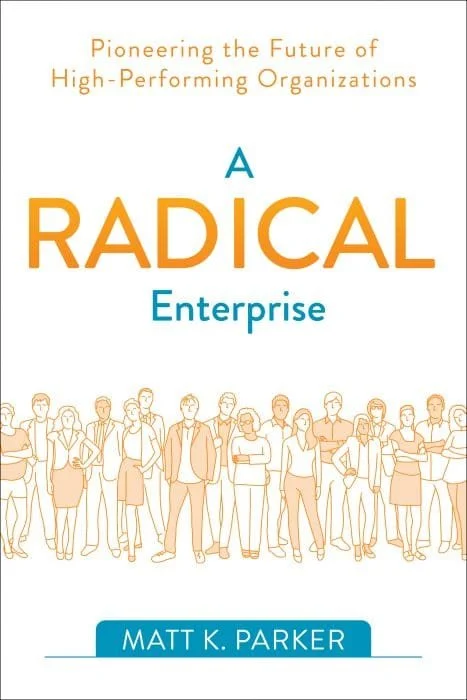A Radical Enterprise: Pioneering the Future of High-Performing Organizations by Matt K. Parker is a curious book. It describes a vastly different way of working in organizations that enables significantly better outcomes - an exciting scenario. At the same time some of the stories and prescriptions made me either disappointed in my own ways of working or think that there is a deep canyon between my current ways of working and this radical new enterprise. Am I ready to try to reach across? And in some cases, Is this for real? To put off some of the skepticism (“this will never work”), Parker brings in examples of companies that have started down the path to becoming high-performing organizations with a very different working model. And these examples come from a variety of industries - IT, manufacturing, consulting, innovation and others - which bolsters the argument that this isn’t something that applies only in one type of firm.
What is a radical enterprise? My take is that is a new choice of how to operate that creates much better collaboration (radical collaboration?) and interpersonal connection within the organization. And that then creates significantly better outcomes for the customers of the organization. The other part of the discussion is “what is NOT a radical enterprise?” And that is essentially what we have now in the familiar description of organizations: strict hierarchy, employees locked into roles/teams, low psychological safety. Parker talks a lot about the dominator hierarchy model in this context.
Parker describes four imperatives of the radical enterprise: Team Autonomy, Managerial Devolution, Deficiency Gratification, and Candid Vulnerability. Each of these get their own discussion, though Parker makes clear that they are not stand-alone factors that one can create without at least some elements from the other imperatives.
Teams operate with autonomy - teams and team members decide for themselves how they work, when and where they work, with whom they work, on what they work, and what role they play in that work. In conjunction with that, you have a devolution of management from the directives-from-on-high mode of the dominator hierarchy to more and more self-management of decision-making, personnel decisions, performance evaluation and even compensation. This was the area where I had the most “is this possible?” reactions while I read. And then there were several examples to back it up.
And to support these new ways of working and organizing, the other two imperatives come along. Deficiency Gratification is an idea from Maslow’s hierarchy of needs that I hadn’t heard before, but when the human physiological, safety, belonging, love and esteem aren’t met, people lose motivation and performance suffers. Organizations that are better able to meet these needs with one another tend to have higher-functioning people. And this almost rolls right into the idea of Candid Vulnerability: people need to be honest about when they don’t know. They need to feel safe to bring the “hidden” conversations out into the open.
One thing that was missing for me was a “roadmap” or maybe some guidance on how to get to this new way of operating. Yes, there were examples how how some companies made the shift - or how they started with this new way of working. But then, I think some of the point of the book and stories is that there are many ways to get there and they are very dependent on where your company is today. Many of the example companies relied on small tests and trials to get where they are now. And Parker warned a number of times that just applying one of the concepts without being prepared to bring in the others could be a recipe for danger.
Another addition that I would like - maybe this is a conversation or discussion, rather than additional book content - is how other exemplar companies might fit into the framework of A Radical Enterprise. In particular, I kept thinking about the software design company, Menlo Innovations, with the work practices and love of each other as articulated in Joy, Inc. It seems that they cover many of the imperatives described in this book.
As I said at the top, A Radical Enterprise is an inspiring description of a new way of working that is good for the people inside the company AND good for the customers and other stakeholders around the company. But, boy oh boy, there are a lot of questions for people who are in traditional organizations about how to get there (or even if it is possible).
Note: I received a review copy of the book from the publisher.
